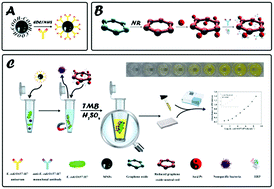Highly sensitive colorimetric immunoassay for Escherichia coli O157:H7 based on probe of pseudo enzyme and dual signal amplification
Abstract
Here we developed a highly sensitive colorimetric immunoassay for the detection of Escherichia coli O157:H7 (E. coli O157:H7). Fe3O4 nanoparticles coated with carboxyl groups were synthesized by a one-pot method and modified with E. coli O157:H7 antiserum as capture probes. Au@Pt nanoparticles with peroxidase-like activity were combined with flaky reduced graphene oxide-neutral red (rGO-NR) to form chromogenic probes of pseudo enzyme. To increase the sensitivity, bovine serum albumin was replaced by horseradish peroxidase (HRP) as blocking protein of immune rGO-NR–Au@Pt. Meanwhile, HRP and Au@Pt constitute a dual signal amplification system. In the presence of E. coli O157:H7, the capture probes and chromogenic probes formed sandwich structures. The complexes were used to catalytically oxidize the chromogenic substrate 3,3′,5,5′-tetramethylbenzidine and the absorbance at 450 nm is related to the concentration of bacteria. Although the feasibility is demonstrated using E. coli O157:H7 as a model analyte, this approach can be easily developed to be a universal analysis system and applied to detection of a wide variety of foodborne pathogens and protein biomarkers. This study proposed a point-of-care and convenient quantitative detection method for clinical diagnostics and food safety analysis.



 Please wait while we load your content...
Please wait while we load your content...